Abstract
Monoclonal antibodies specific to HLA antigens and the fluorescence-activated cell sorter were used to analyze the changes in the density of human histocompatibility antigens HLA-A,B and HLA-DR on the surface of synchronously growing WI-L2 cells (a human B cell line) progressing through the cell cycle. The WI-L2 cells were synchronized by density-dependent arrest in G1, and samples from G0, G1, late S and late G2 phases were used to determine the frequency distribution of cell volume, DNA content, and the relative amounts of cell surface HLA antigens; the observed density changes were calculated from these values. The HLA-A,B density remained nearly constant throughout the cell cycle, whereas the HLA-DR density increased sharply at the G2-M stage. These results suggest a cell cycle-dependent differential control of the expression of these two sets of histocompatibility antigens on B cells.
Full text
PDF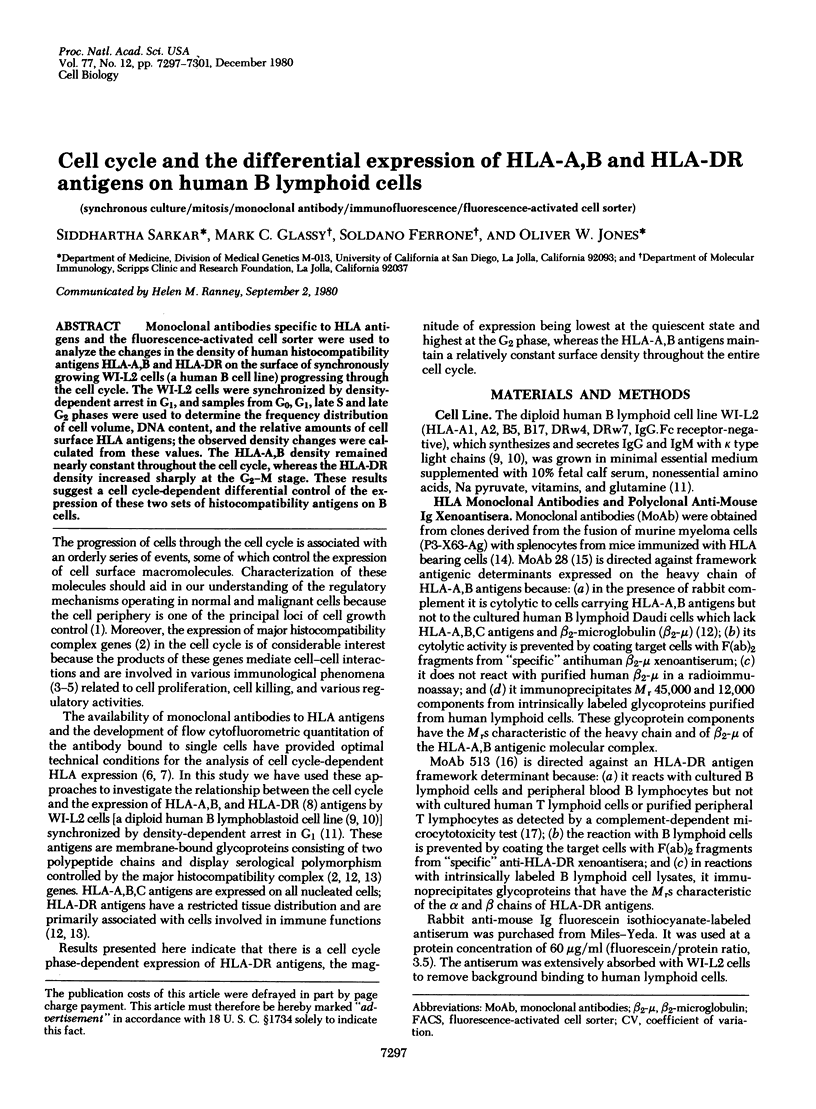
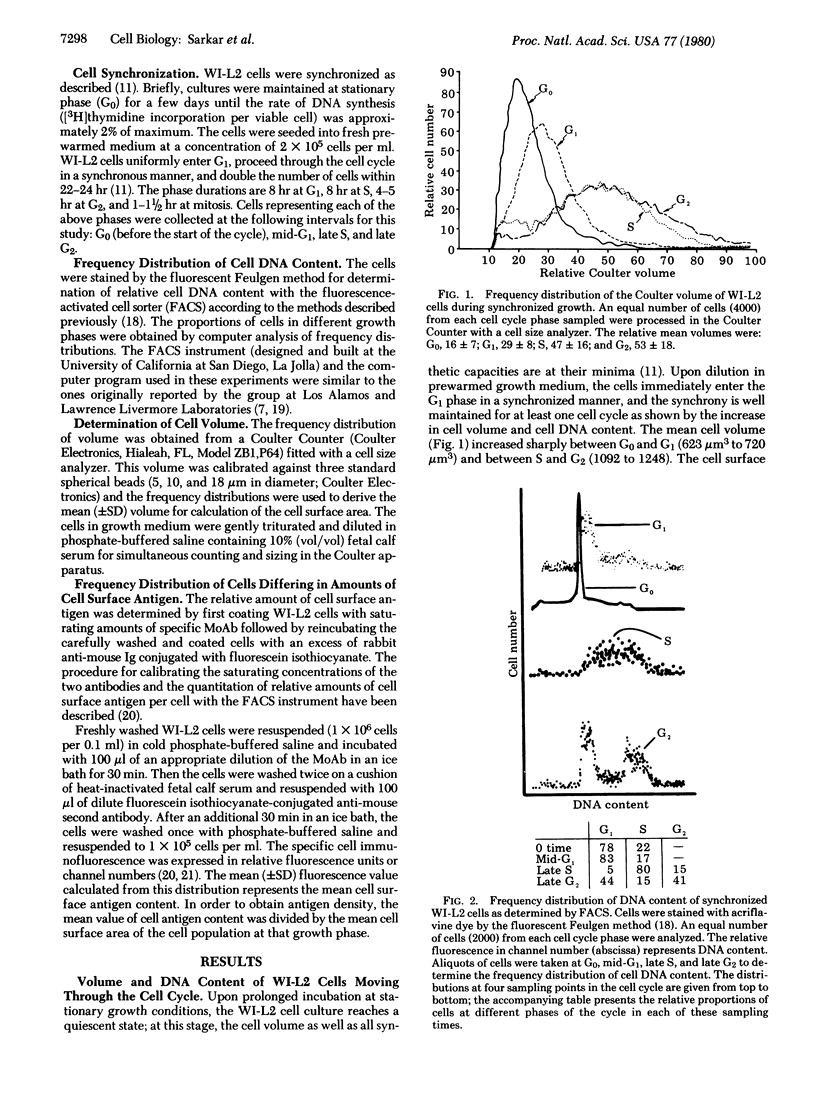
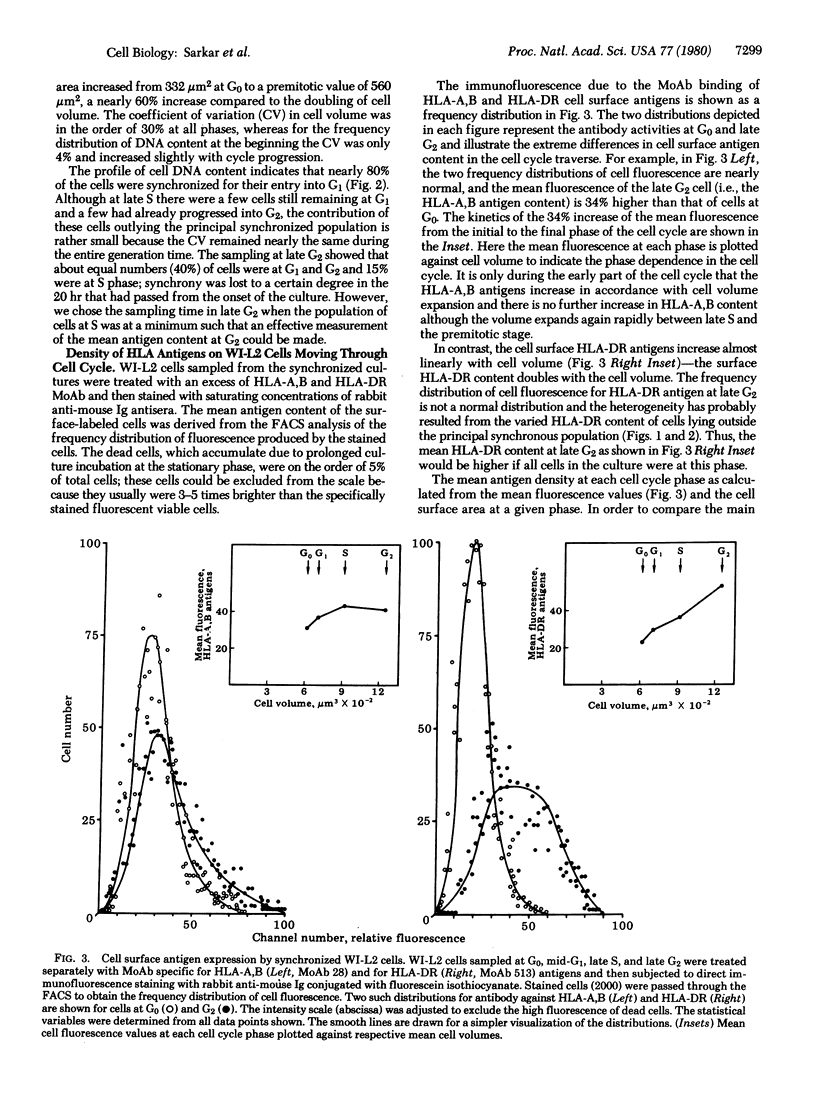
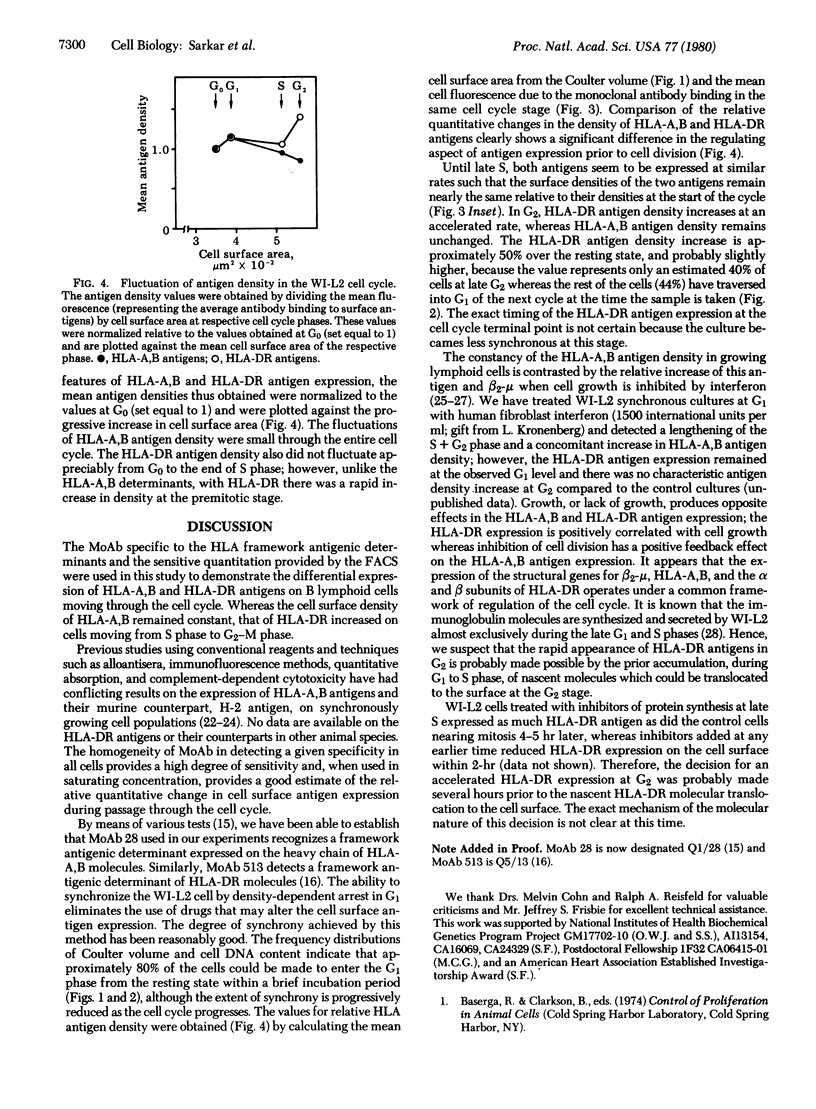
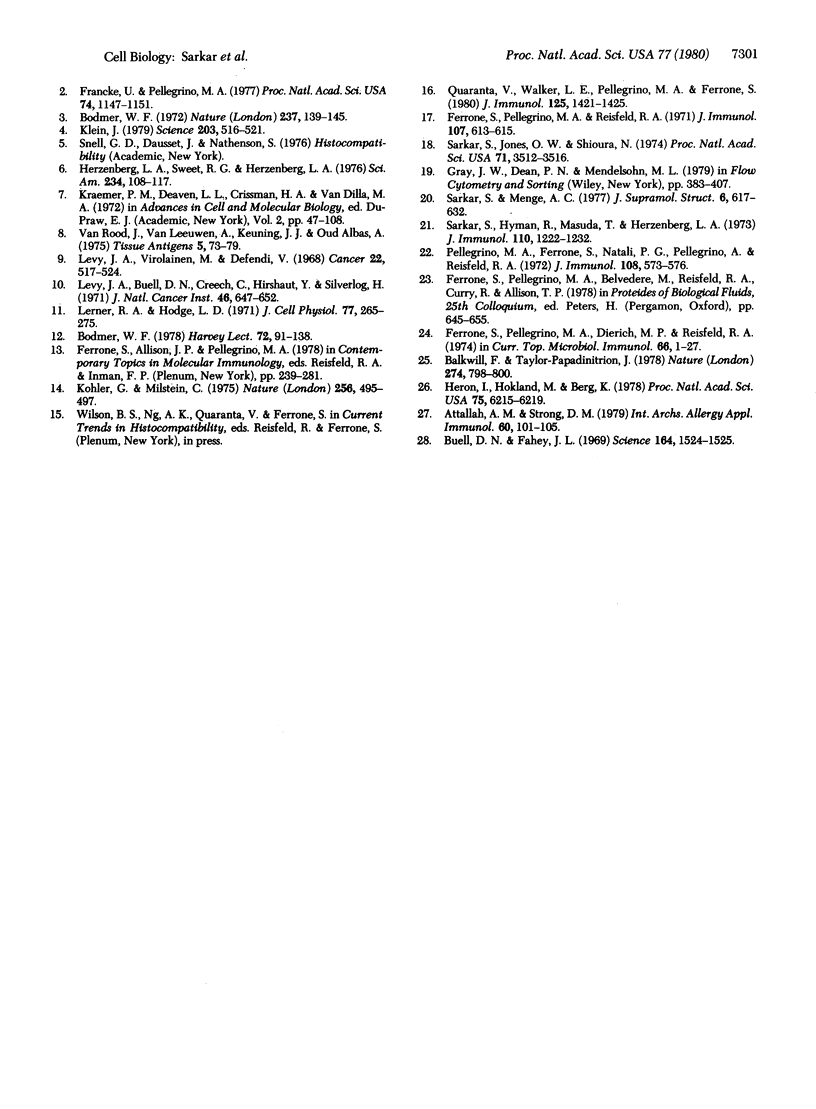
Selected References
These references are in PubMed. This may not be the complete list of references from this article.
- Attallah A. M., Strong D. M. Differential effects of interferon on the MHC expression of human lymphocytes. Enhanced expression of HLA without effect on Ia. Int Arch Allergy Appl Immunol. 1979;60(1):101–105. doi: 10.1159/000232328. [DOI] [PubMed] [Google Scholar]
- Balkwill F., Taylor-Papadimitriou J. Interferon affects both G1 and S+G2 in cells stimulated from quiescence to growth. Nature. 1978 Aug 24;274(5673):798–800. doi: 10.1038/274798a0. [DOI] [PubMed] [Google Scholar]
- Bodmer W. F. Evolutionary significance of the HL-A system. Nature. 1972 May 19;237(5351):139–passim. doi: 10.1038/237139a0. [DOI] [PubMed] [Google Scholar]
- Bodmer W. F. HLA: a super supergene. Harvey Lect. 1978;72:91–138. [PubMed] [Google Scholar]
- Buell D. N., Fahey J. L. Limited periods of gene expression in immunoglobulin-synthesizing cells. Science. 1969 Jun 27;164(3887):1524–1525. doi: 10.1126/science.164.3887.1524. [DOI] [PubMed] [Google Scholar]
- Ferrone S., Pellegrino M. A., Dierich M. P., Reisfeld R. A. Expression of histocompatibility antigens during the growth cycle of cultured lymphoid cells. Curr Top Microbiol Immunol. 1974;66:1–27. doi: 10.1007/978-3-642-65908-9_1. [DOI] [PubMed] [Google Scholar]
- Ferrone S., Pellegrino M. A., Reisfeld R. A. A rapid method for direct HL-A typing of cultured lymphoid cells. J Immunol. 1971 Aug;107(2):613–615. [PubMed] [Google Scholar]
- Francke U., Pellegrino M. A. Assignment of the major histocompatibility complex to a region of the short arm of human chromosome 6. Proc Natl Acad Sci U S A. 1977 Mar;74(3):1147–1151. doi: 10.1073/pnas.74.3.1147. [DOI] [PMC free article] [PubMed] [Google Scholar]
- Heron I., Hokland M., Berg K. Enhanced expression of beta2-microglobulin and HLA antigens on human lymphoid cells by interferon. Proc Natl Acad Sci U S A. 1978 Dec;75(12):6215–6219. doi: 10.1073/pnas.75.12.6215. [DOI] [PMC free article] [PubMed] [Google Scholar]
- Herzenberg L. A., Sweet R. G., Herzenberg L. A. Fluorescence-activated cell sorting. Sci Am. 1976 Mar;234(3):108–117. doi: 10.1038/scientificamerican0376-108. [DOI] [PubMed] [Google Scholar]
- Klein J. The major histocompatibility complex of the mouse. Science. 1979 Feb 9;203(4380):516–521. doi: 10.1126/science.104386. [DOI] [PubMed] [Google Scholar]
- Köhler G., Milstein C. Continuous cultures of fused cells secreting antibody of predefined specificity. Nature. 1975 Aug 7;256(5517):495–497. doi: 10.1038/256495a0. [DOI] [PubMed] [Google Scholar]
- Lerner R. A., Hodge L. D. Gene expression in synchronized lymphocytes: studies on the control of synthesis of immunoglobulin polypeptides. J Cell Physiol. 1971 Apr;77(2):265–276. doi: 10.1002/jcp.1040770215. [DOI] [PubMed] [Google Scholar]
- Levy J. A., Buell D. N., Creech C., Hirshaut Y., Silverberg H. Further characterization of the WI-L1 and WI-L2 lymphoblastoid lines. J Natl Cancer Inst. 1971 Mar;46(3):647–654. [PubMed] [Google Scholar]
- Levy J. A., Virolainen M., Defendi V. Human lymphoblastoid lines from lymph node and spleen. Cancer. 1968 Sep;22(3):517–524. doi: 10.1002/1097-0142(196809)22:3<517::aid-cncr2820220305>3.0.co;2-a. [DOI] [PubMed] [Google Scholar]
- Pellegrino M. A., Ferrone S., Natali P. G., Pellegrino A., Reisfeld R. A. Expression of HL-A antigens in synchronized cultures of human lymphocytes. J Immunol. 1972 Feb;108(2):573–576. [PubMed] [Google Scholar]
- Quaranta V., Walker L. E., Pellegrino M. A., Ferrone S. Purification of immunologically functional subsets of human Ia-like antigens on a monoclonal antibody (Q5/13) immunoadsorbent. J Immunol. 1980 Oct;125(4):1421–1425. [PubMed] [Google Scholar]
- Sarkar S. Cell antigens recognized by rabbit antibodies specific for oligomannosyl determinants. J Supramol Struct. 1977;6(4):617–632. doi: 10.1002/jss.400060414. [DOI] [PubMed] [Google Scholar]
- Sarkar S., Hyman R., Masuda T., Herzenberg L. A. A rabbit antiserum to a thymus extract specific for mouse thymus-derived cells. J Immunol. 1973 May;110(5):1222–1232. [PubMed] [Google Scholar]
- Sarkar S., Jones O. W., Shioura N. Constancy in human sperm DNA content. Proc Natl Acad Sci U S A. 1974 Sep;71(9):3512–3516. doi: 10.1073/pnas.71.9.3512. [DOI] [PMC free article] [PubMed] [Google Scholar]
- van Rood J. J., van Leeuwen A., Keuning J. J., van Oud Alblas A. B. The serological recognition of the human MLC determinants using a modified cytotoxicity technique. Tissue Antigens. 1975 Apr;5(2):73–79. doi: 10.1111/j.1399-0039.1975.tb00532.x. [DOI] [PubMed] [Google Scholar]


